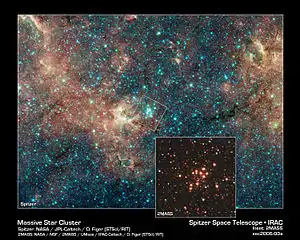RSGC1-F01
RSGC1-F01 is a red supergiant located in the RSGC1 open cluster in the constellation of Scutum. The radius was calculated to be around 1,530[2] times that of the Sun (the radius is calculated by applying the Stefan-Bolzmann law), making it one of the largest stars discovered so far. This corresponds to a volume 3.58 billion times bigger than the Sun. If placed at the center of the Solar System, the photosphere would engulf the orbit of Jupiter.
| Observation data Epoch J2000 Equinox J2000 | |
|---|---|
| Constellation | Scutum |
| Right ascension | 18h 37m 56.29s[1] |
| Declination | −6° 52′ 32.2″[1] |
| Characteristics | |
| Spectral type | M3 / M5[2] |
| Apparent magnitude (J) | 9.748[1] |
| Apparent magnitude (H) | 6.587[1] |
| Details | |
| Radius | 1,530[2] R☉ |
| Luminosity | 335,000[2] - 380,000[3] L☉ |
| Temperature | 3,550[2] K |
| Other designations | |
RSGC1-F01, 2MASS J18375629-0652322 | |
| Database references | |
| SIMBAD | data |
See also
References
- Davies, Ben; Figer, Don F.; Law, Casey J.; Kudritzki, Rolf-Peter; Najarro, Francisco; Herrero, Artemio; MacKenty, John W. (2008). "The cool supergiant population of the massive young star cluster RSGC1". The Astrophysical Journal. 676 (2): 1016–1028. arXiv:0711.4757. Bibcode:2008ApJ...676.1016D. doi:10.1086/527350. ISSN 0004-637X.
- Humphreys, Roberta M.; Helmel, Greta; Jones, Terry J.; Gordon, Michael S. (2020). "Exploring the Mass Loss Histories of the Red Supergiants". The Astronomical Journal. 160 (3): 145. arXiv:2008.01108. Bibcode:2020AJ....160..145H. doi:10.3847/1538-3881/abab15. S2CID 220961677.
- Emma Bensor (2020). "A new mass-loss rate prescription for red supergiants". Monthly Notices of the Royal Astronomical Society. 492 (4): 5994–6006. arXiv:2001.07222. Bibcode:2020MNRAS.492.5994B. doi:10.1093/mnras/staa255. S2CID 210839222.
This article is issued from Wikipedia. The text is licensed under Creative Commons - Attribution - Sharealike. Additional terms may apply for the media files.
